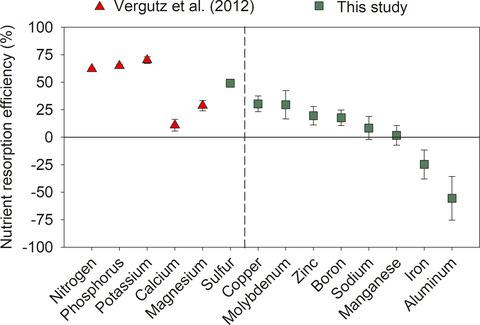当前位置:
X-MOL 学术
›
Funct. Ecol.
›
论文详情
Our official English website, www.x-mol.net, welcomes your
feedback! (Note: you will need to create a separate account there.)
Global resorption efficiencies of trace elements in leaves of terrestrial plants
Functional Ecology ( IF 4.6 ) Pub Date : 2021-04-19 , DOI: 10.1111/1365-2435.13809 Hao Chen 1, 2 , Sasha C. Reed 3 , Xiaotao Lü 4 , Kongcao Xiao 2, 5 , Kelin Wang 2, 5 , Dejun Li 2, 5
中文翻译:

陆生植物叶片中微量元素的整体吸收效率
更新日期:2021-04-19
Functional Ecology ( IF 4.6 ) Pub Date : 2021-04-19 , DOI: 10.1111/1365-2435.13809 Hao Chen 1, 2 , Sasha C. Reed 3 , Xiaotao Lü 4 , Kongcao Xiao 2, 5 , Kelin Wang 2, 5 , Dejun Li 2, 5
Affiliation

|
- Leaf nutrient resorption is a critical nutrient conservation strategy. Previous studies focus mainly on resorption patterns of macronutrients, but resorption patterns of trace elements remain poorly understood.
- A meta-analysis was conducted to explore the general patterns of the leaf resorption of eight trace elements [i.e. copper (Cu), molybdenum (Mo), zinc (Zn), boron (B), manganese (Mn), sodium (Na), aluminium (Al) and iron (Fe)], and a macronutrient [i.e. sulphur (S)] using data collected from 53 published studies.
- Sulphur (49.6%) had the highest average resorption efficiency followed by Cu (30.3%), Mo (29.5%), Zn (19.5%) and B (17.6%). Two structural elements, Na and Mn, were not resorbed, whereas two potentially toxic elements, Al (−55.6%) and Fe (−25.4%), were accumulated in senesced leaves. Both climatic factors and growth types affected leaf nutrient resorption efficiency, but the magnitudes and directions of the effects differed greatly between S and the trace elements. The resorption efficiencies of S, Cu, Mo and Zn decreased as leaf nutrient concentrations increased, but the structural or potentially toxic elements (i.e. B, Mn, Na, Fe and Al) presented no response or opposite trends.
- Our results provide global mean resorption efficiencies of trace elements for the first time, and highlight that structural and potentially toxic elements have relatively lower or no leaf resorption, which should be fully considered in biogeochemical models.
中文翻译:

陆生植物叶片中微量元素的整体吸收效率
- 叶片养分吸收是一种重要的养分保护策略。以前的研究主要集中在常量营养素的吸收模式上,但对微量元素的吸收模式仍然知之甚少。
- 进行了一项荟萃分析来探索八种微量元素 [即铜 (Cu)、钼 (Mo)、锌 (Zn)、硼 (B)、锰 (Mn)、钠 (Na) 、铝 (Al) 和铁 (Fe)],以及一种常量营养素 [即硫 (S)],使用从 53 项已发表研究中收集的数据。
- 硫 (49.6%) 的平均再吸收效率最高,其次是 Cu (30.3%)、Mo (29.5%)、Zn (19.5%) 和 B (17.6%)。两种结构元素 Na 和 Mn 没有被吸收,而两种潜在的有毒元素 Al (-55.6%) 和 Fe (-25.4%) 在衰老的叶子中积累。气候因素和生长类型都影响叶片养分吸收效率,但影响的大小和方向在硫和微量元素之间存在很大差异。随着叶片养分浓度的增加,S、Cu、Mo 和 Zn 的吸收效率降低,但结构性或潜在毒性元素(即 B、Mn、Na、Fe 和 Al)没有反应或呈相反趋势。
- 我们的结果首次提供了微量元素的全球平均吸收效率,并强调结构和潜在有毒元素的叶片吸收相对较低或没有,这应该在生物地球化学模型中得到充分考虑。











































 京公网安备 11010802027423号
京公网安备 11010802027423号